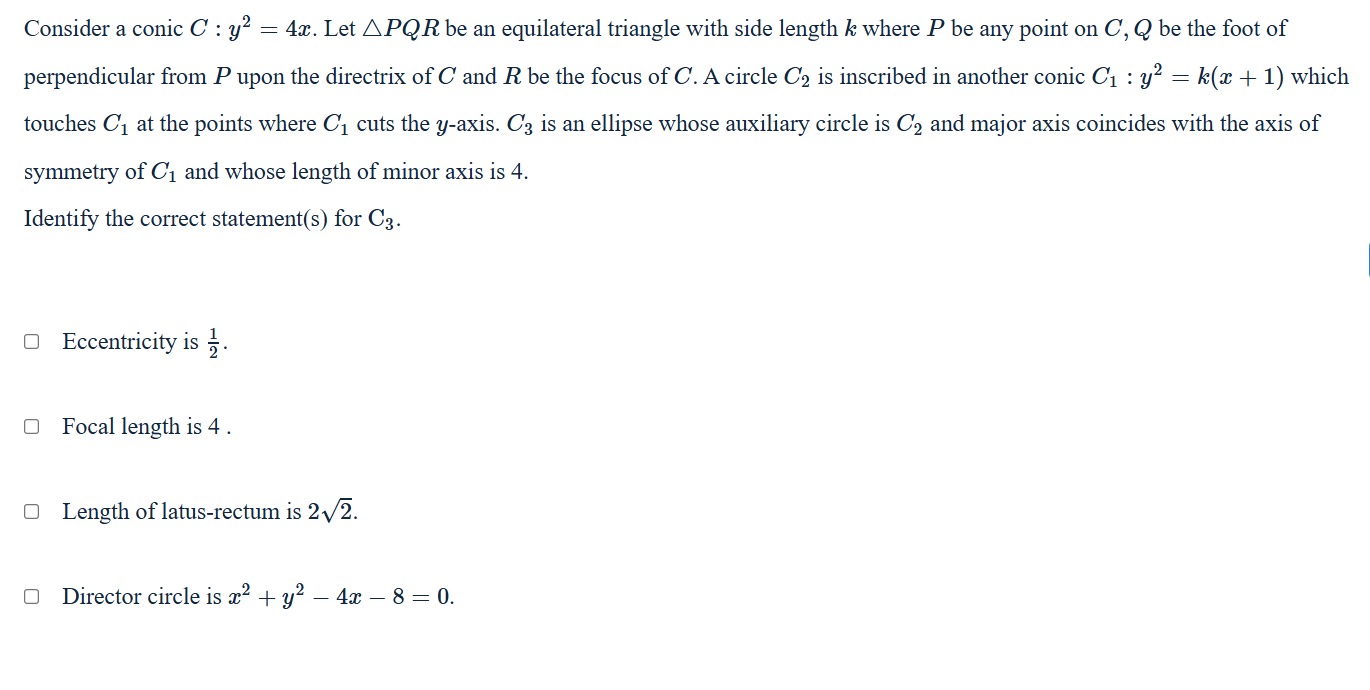Question
Question: Consider a conic $C: y^2 = 4x$. Let $\triangle PQR$ be an equilateral triangle with side length $k$ ...
Consider a conic C:y2=4x. Let △PQR be an equilateral triangle with side length k where P be any point on C, Q be the foot of perpendicular from P upon the directrix of C and R be the focus of C. A circle C2 is inscribed in another conic C1:y2=k(x+1) which touches C1 at the points where C1 cuts the y-axis. C3 is an ellipse whose auxiliary circle is C2 and major axis coincides with the axis of symmetry of C1 and whose length of minor axis is 4.
Identify the correct statement(s) for C3.

Eccentricity is 21.
Focal length is 4.
Length of latus-rectum is 22.
Director circle is x2+y2−4x−8=0.
Focal length is 4., Length of latus-rectum is 22., Director circle is x2+y2−4x−8=0.
Solution
The given conic is C:y2=4x. This is a parabola with a=1. The focus of C is R=(1,0). The directrix of C is x=−1. Let P(xP,yP) be a point on C, so yP2=4xP. Q is the foot of the perpendicular from P upon the directrix x=−1, so Q=(−1,yP). △PQR is an equilateral triangle with side length k. The distance PQ=(xP−(−1))2+(yP−yP)2=(xP+1)2=∣xP+1∣. Since xP≥0 for yP2=4xP, PQ=xP+1. The distance QR=(−1−1)2+(yP−0)2=(−2)2+yP2=4+yP2. Since △PQR is equilateral, PQ=QR=k. So k=xP+1 and k2=4+yP2. From k=xP+1, we get xP=k−1. Substitute xP into yP2=4xP: yP2=4(k−1). Substitute yP2 into k2=4+yP2: k2=4+4(k−1)=4+4k−4=4k. Since k is a side length, k>0. Dividing by k, we get k=4.
The conic C1 is y2=k(x+1), which is y2=4(x+1). This is a parabola with vertex (−1,0) and axis of symmetry y=0 (the x-axis). C1 cuts the y-axis when x=0: y2=4(0+1)=4, so y=±2. The intersection points are (0,2) and (0,−2). A circle C2 is inscribed in C1 and touches C1 at (0,2) and (0,−2). Since the points of tangency are symmetric about the x-axis, the center of C2 lies on the x-axis. Let the center be (hc,0). The equation of C2 is (x−hc)2+y2=r2. The points (0,2) and (0,−2) lie on C2: (0−hc)2+22=r2⟹hc2+4=r2. The radius to the point of tangency is perpendicular to the tangent. The tangent to y2=4(x+1) at (0,2) has slope dxdy from 2ydxdy=4⟹dxdy=y2. At (0,2), the slope of the tangent is mt=22=1. The slope of the radius from (hc,0) to (0,2) is mr=0−hc2−0=−hc2. Since mrmt=−1, we have (−hc2)(1)=−1⟹hc=2. The center of C2 is (2,0). The radius squared is r2=hc2+4=22+4=8. The equation of C2 is (x−2)2+y2=8.
C3 is an ellipse whose auxiliary circle is C2 and major axis coincides with the axis of symmetry of C1. The axis of symmetry of C1 is the x-axis (y=0). The major axis of C3 is along the x-axis. The auxiliary circle C2 is centered at (2,0), so the center of the ellipse C3 is also (2,0). The equation of the auxiliary circle of an ellipse a2(x−h)2+b2(y−k)2=1 with a>b is (x−h)2+(y−k)2=a2. Comparing (x−2)2+y2=8 with (x−2)2+y2=aell2, we get aell2=8. Since the major axis is along the x-axis, aell2 is the larger denominator. aell=8=22. The length of the minor axis is given as 4, so 2bell=4⟹bell=2. bell2=4. The equation of the ellipse C3 is 8(x−2)2+4y2=1.
Now let's check the statements for C3:
- Eccentricity e: bell2=aell2(1−e2)⟹4=8(1−e2)⟹21=1−e2⟹e2=21⟹e=21=22. Statement says e=21. Incorrect.
- Focal length: The distance from the center (2,0) to each focus is aelle=(22)(21)=2. The foci are at (2±2,0), which are (4,0) and (0,0). The focal length (distance between foci) is (4−0)2+(0−0)2=4. Statement says focal length is 4. Correct.
- Length of latus-rectum: aell2bell2=222(4)=228=24=22. Statement says length of latus-rectum is 22. Correct.
- Director circle: The equation of the director circle for a2(x−h)2+b2(y−k)2=1 is (x−h)2+(y−k)2=a2+b2. For C3:8(x−2)2+4y2=1, the director circle is (x−2)2+y2=8+4=12. (x−2)2+y2=12 x2−4x+4+y2=12 x2+y2−4x−8=0. Statement says director circle is x2+y2−4x−8=0. Correct.
The correct statements are 2, 3, and 4.
